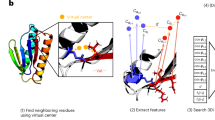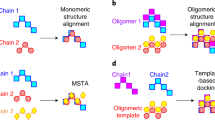Abstract
SCWRL and MolIDE are software applications for prediction of protein structures. SCWRL is designed specifically for the task of prediction of side-chain conformations given a fixed backbone usually obtained from an experimental structure determined by X-ray crystallography or NMR. SCWRL is a command-line program that typically runs in a few seconds. MolIDE provides a graphical interface for basic comparative (homology) modeling using SCWRL and other programs. MolIDE takes an input target sequence and uses PSI-BLAST to identify and align templates for comparative modeling of the target. The sequence alignment to any template can be manually modified within a graphical window of the target–template alignment and visualization of the alignment on the template structure. MolIDE builds the model of the target structure on the basis of the template backbone, predicted side-chain conformations with SCWRL and a loop-modeling program for insertion–deletion regions with user-selected sequence segments. SCWRL and MolIDE can be obtained at http://dunbrack.fccc.edu/Software.php.
This is a preview of subscription content, access via your institution
Access options
Subscribe to this journal
Receive 12 print issues and online access
$259.00 per year
only $21.58 per issue
Buy this article
- Purchase on Springer Link
- Instant access to full article PDF
Prices may be subject to local taxes which are calculated during checkout






Similar content being viewed by others
References
Berman, H., Henrick, K., Nakamura, H. & Markley, J.L. The worldwide Protein Data Bank (wwPDB): ensuring a single, uniform archive of PDB data. Nucleic Acids Res. 35, D301–D303 (2007).
Wang, G. & Dunbrack, R.L. Jr. PISCES: recent improvements to a PDB sequence culling server. Nucleic Acids Res. 33, W94–W98 (2005).
Lo Conte, L. et al. SCOP: a structural classification of proteins database. Nucleic Acids Res. 28, 257–259 (2000).
Perutz, M.F., Kendrew, J.C. & Watson, H.C. Structure and function of haemoglobin. J. Mol. Biol. 13, 669–678 (1965).
Browne, W.J., North, A.C. & Phillips, D.C. A possible three-dimensional structure of bovine alpha-lactalbumin based on that of hen's egg-white lysozyme. J. Mol. Biol. 42, 65–86 (1969).
Jones, D.T., Taylor, W.R. & Thornton, J.M. A new approach to protein fold recognition. Nature 358, 86–89 (1992).
Jaroszewski, L., Rychlewski, L., Li, Z., Li, W. & Godzik, A. FFAS03: a server for profile–profile sequence alignments. Nucleic Acids Res. 33, W284–W288 (2005).
Havel, T.F. & Snow, M.E. A new method for building protein conformations from sequence alignments with homologues of known structure. J. Mol. Biol. 217, 1–7 (1991).
Sali, A. & Blundell, T.L. Comparative protein modelling by satisfaction of spatial restraints. J. Mol. Biol. 234, 779–815 (1993).
Sanchez, R. & Sali, A. Evaluation of comparative protein structure modeling by MODELLER-3. Proteins (Suppl): 50–58 (1997).
Li, H. et al. Homology modeling using simulated annealing of restrained molecular dynamics and conformational search calculations with CONGEN: application in predicting the three-dimensional structure of murine homeodomain Msx-1. Protein Sci. 6, 956–970 (1997).
Sahasrabudhe, P.V., Tejero, R., Kitao, S., Furuichi, Y. & Montelione, G.T. Homology modeling of an RNP domain from a human RNA-binding protein: homology-constrained energy optimization provides a criterion for distinguishing potential sequence alignments. Proteins 33, 558–566 (1998).
Lichtarge, O., Bourne, H.R. & Cohen, F.E. An evolutionary trace method defines binding surfaces common to protein families. J. Mol. Biol. 257, 342–358 (1996).
Fetrow, J.S., Godzik, A. & Skolnick, J. Functional analysis of the Escherichia coli genome using the sequence-to-structure-to-function paradigm: identification of proteins exhibiting the glutaredoxin/thioredoxin disulfide oxidoreductase activity. J. Mol. Biol. 282, 703–711 (1998).
Whisstock, J.C. & Lesk, A.M. Prediction of protein function from protein sequence and structure. Q. Rev. Biophys. 36, 307–340 (2003).
Laskowski, R.A., Watson, J.D. & Thornton, J.M. ProFunc: a server for predicting protein function from 3D structure. Nucleic Acids Res. 33, W89–W93 (2005).
Najmanovich, R.J., Torrance, J.W. & Thornton, J.M. Prediction of protein function from structure: insights from methods for the detection of local structural similarities. Biotechniques 38, 847, 849, 851 (2005).
Watson, J.D., Laskowski, R.A. & Thornton, J.M. Predicting protein function from sequence and structural data. Curr. Opin. Struct. Biol. 15, 275–284 (2005).
Kim, S.H. et al. Structure-based functional inference in structural genomics. J. Struct. Funct. Genomics 4, 129–135 (2003).
Zoller, B. & Dahlback, B. Linkage between inherited resistance to activated protein C and factor V gene mutation in venous thrombosis. Lancet 343, 1536–1538 (1994).
Bogaerts, V. et al. Genetic variability in the mitochondrial serine protease HTRA2 contributes to risk for Parkinson disease. Hum. Mutat. (2008).
Couch, F.J. & Weber, B.L. Mutations and polymorphisms in the familial early-onset breast cancer (BRCA1) gene. Breast Cancer Information Core. Hum. Mutat. 8, 8–18 (1996).
Karchin, R. et al. LS-SNP: large-scale annotation of coding non-synonymous SNPs based on multiple information sources. Bioinformatics 21, 2814–2820 (2005).
Weber, I.T. et al. Molecular modeling of the HIV-1 protease and its substrate binding site. Science 243, 928–931 (1989).
Weber, I.T. Evaluation of homology modeling of HIV protease. Proteins 7, 172–184 (1990).
Ring, C.S. et al. Structure-based inhibitor design by using protein models for the development of antiparasitic agents. Proc. Natl. Acad. Sci. USA 90, 3583–3587 (1993).
Park, H. et al. Discovery of novel alpha-glucosidase inhibitors based on the virtual screening with the homology-modeled protein structure. Bioorg. Med. Chem. 16, 284–292 (2008).
Bower, M., Cohen, F.E. & R.L. Dunbrack, J. SCWRL: a program for building sidechains onto protein backbones (http://www.cmpharm.ucsf.edu/∼bower/scwrl.html, University of California San Francisco, San Francisco, CA, 1997).
Canutescu, A.A., Shelenkov, A.A. & Dunbrack, R.L. Jr. A graph-theory algorithm for rapid protein side-chain prediction. Protein Sci. 12, 2001–2014 (2003).
Wallner, B. & Elofsson, A. All are not equal: a benchmark of different homology modeling programs. Protein Sci. 14, 1315–1327 (2005).
Canutescu, A.A. & Dunbrack, R.L. Jr. MollDE: a homology modeling framework you can click with. Bioinformatics 21, 2914–2916 (2005).
Qian, B. et al. High-resolution structure prediction and the crystallographic phase problem. Nature 450, 259–264 (2007).
Dunbrack, R.L. Jr. & Karplus, M. Backbone-dependent rotamer library for proteins. Application to side-chain prediction. J. Mol. Biol. 230, 543–574 (1993).
Dunbrack, R.L. Jr. & Cohen, F.E. Bayesian statistical analysis of protein side-chain rotamer preferences. Protein Sci. 6, 1661–1681 (1997).
Dunbrack, R.L. Jr. Rotamer libraries in the 21st century. Curr. Opin. Struct. Biol. 12, 431–440 (2002).
Lovell, S.C., Word, J.M., Richardson, J.S. & Richardson, D.C. The penultimate rotamer library. Proteins 40, 389–408 (2000).
Lovell, S.C., Word, J.M., Richardson, J.S. & Richardson, D.C. Asparagine and glutamine rotamers: B-factor cutoff and correction of amide flips yield distinct clustering. Proc. Natl. Acad. Sci. USA 96, 400–405 (1999).
Altschul, S.F. et al. Gapped BLAST and PSI-BLAST: a new generation of database programs. Nucleic Acids Res. 25, 3389–3402 (1997).
Wheeler, D.L. et al. Database resources of the National Center for Biotechnology Information. Nucleic Acids Res. 36, D13–D21 (2008).
Jones, D.T. Protein secondary structure prediction based on position-specific scoring matrices. J. Mol. Biol. 292, 195–202 (1999).
Xu, Q., Canutescu, A., Obradovic, Z. & Dunbrack, R.L. Jr. ProtBuD: a database of biological unit structures of protein families and superfamilies. Bioinformatics 22, 2876–2882 (2006).
Sauder, J.M., Arthur, J.W. & Dunbrack, R.L. Jr. Large-scale comparison of protein sequence alignment algorithms with structure alignments. Proteins 40, 6–22 (2000).
Xiang, Z., Soto, C.S. & Honig, B. Evaluating conformational free energies: the colony energy and its application to the problem of protein loop prediction. Proc. Natl. Acad. Sci. USA 99, 7432–7437 (2002).
Ward, J.J., McGuffin, L.J., Bryson, K., Buxton, B.F. & Jones, D.T. The DISOPRED server for the prediction of protein disorder. Bioinformatics 20, 2138–2139 (2004).
Schwede, T., Kopp, J., Guex, N. & Peitsch, M.C. SWISS-MODEL: an automated protein homology-modeling server. Nucleic Acids Res. 31, 3381–3385 (2003).
Pieper, U. et al. MODBASE: a database of annotated comparative protein structure models and associated resources. Nucleic Acids Res. 34, D291–D295 (2006).
Ye, Y. & Godzik, A. FATCAT: a web server for flexible structure comparison and structure similarity searching. Nucleic Acids Res. 32, W582–W585 (2004).
MacKerell, A.D. Jr. et al. All-atom empirical potential for molecular modeling and dynamics studies of proteins. J. Phys. Chem. B102, 3586–3616 (1998).
Bateman, A. The structure of a domain common to archaebacteria and the homocystinuria disease protein. Trends Biochem. Sci. 22, 12–13 (1997).
Shan, X., Dunbrack, R.L. Jr., Christopher, S.A. & Kruger, W.D. Mutations in the regulatory domain of cystathionine beta synthase can functionally suppress patient-derived mutations in cis. Hum. Mol. Genet. 10, 635–643 (2001).
Proudfoot, M. et al. Biochemical and structural characterization of a novel family of cystathionine beta-synthase domain proteins fused to a Zn ribbon-like domain. J. Mol. Biol. 375, 301–315 (2008).
Acknowledgements
This work was supported by NIH grants R01-HG02302 and R01-GM84453 (to R.L.D.) and P30-CA06927 to Fox Chase Cancer Center. We thank Mark Andrake and Radka Stoyanova for testing MolIDE 1.6.
Author information
Authors and Affiliations
Corresponding author
Rights and permissions
About this article
Cite this article
Wang, Q., Canutescu, A. & Dunbrack, R. SCWRL and MolIDE: computer programs for side-chain conformation prediction and homology modeling. Nat Protoc 3, 1832–1847 (2008). https://doi.org/10.1038/nprot.2008.184
Published:
Issue Date:
DOI: https://doi.org/10.1038/nprot.2008.184
This article is cited by
-
Crystal structure of dopamine D1 receptor in complex with G protein and a non-catechol agonist
Nature Communications (2021)
-
Protein Structure Prediction: Conventional and Deep Learning Perspectives
The Protein Journal (2021)
-
RNAfitme: a webserver for modeling nucleobase and nucleoside residue conformation in fixed-backbone RNA structures
BMC Bioinformatics (2018)
-
A hydroquinone-specific screening system for directed P450 evolution
Applied Microbiology and Biotechnology (2018)
-
Comparative Modeling and Evaluation of Leukotriene B4 Receptors for Selective Drug Discovery Towards the Treatment of Inflammatory Diseases
The Protein Journal (2018)
Comments
By submitting a comment you agree to abide by our Terms and Community Guidelines. If you find something abusive or that does not comply with our terms or guidelines please flag it as inappropriate.



